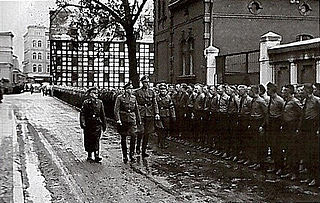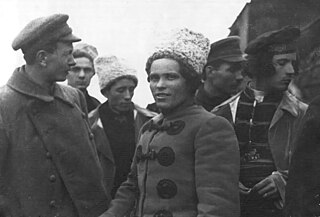
Peter Andreyevich Arshinov, was a Russian anarchist revolutionary and intellectual who chronicled the history of the Makhnovshchina.

Nestor Ivanovych Makhno, also known as Batko Makhno, was a Ukrainian anarchist revolutionary and the commander of the Revolutionary Insurgent Army of Ukraine during the Ukrainian War of Independence. He established the Makhnovshchina, a mass movement by the Ukrainian peasantry to establish anarchist communism in the country between 1918 and 1921. Initially centered around Makhno's home province of Katerynoslav and hometown of Huliaipole, it came to exert a strong influence over large areas of southern Ukraine, specifically in what is now the Zaporizhzhia Oblast of Ukraine.

The Russian Mennonites are a group of Mennonites who are the descendants of Dutch and North German Anabaptists who settled in the Vistula delta in West Prussia for about 250 years and established colonies in the Russian Empire beginning in 1789. Since the late 19th century, many of them have emigrated to countries which are located throughout the Western Hemisphere. The rest of them were forcibly relocated, so very few of their descendants currently live in the locations of the original colonies. Russian Mennonites are traditionally multilingual but Plautdietsch is their first language as well as their lingua franca. In 2014, there were several hundred thousand Russian Mennonites: about 200,000 live in Germany, 74,122 live in Mexico, 150,000 in Bolivia, 40,000 live in Paraguay, 10,000 live in Belize, tens of thousands of them live in Canada and the US, and a few thousand live in Argentina, Uruguay, and Brazil.

Selbstschutz is the name given to different iterations of ethnic-German self-protection units formed both after the First World War and in the lead-up to the Second World War.

Chortitza Colony was a volost, a subdivision of the Yekaterinoslav uezd within the Yekaterinoslav Governorate. During the times of Catherine the Great, the area was annexed by the Russian Empire after liquidation of the Zaporozhian Sich. It was granted to Plautdietsch-speaking settlers for colonization northwest of Khortytsia Island. The territory of the former colony is now split between the city of Zaporizhzhia and its adjacent Zaporizhzhia Raion, within Zaporizhia it is part of Voznesenskyi and Khortytskyi districts.
The Makhnovshchina was a mass movement to establish anarchist communism in southern and eastern Ukraine during the Ukrainian War of Independence of 1917–1921. Named after Nestor Makhno, the commander-in-chief of the Revolutionary Insurgent Army of Ukraine, its aim was to create a system of free soviets that would manage the transition towards a stateless and classless society.
Molotschna Colony or Molochna Colony was a Russian Mennonite settlement in what is now Zaporizhzhia Oblast in Ukraine. Today, the central village, known as Molochansk, has a population less than 10,000. The settlement is named after the Molochna River which forms its western boundary. The land falls mostly within the Tokmatskyi and Chernihivskyi Raions. The nearest large city is Melitopol, southwest of Molochansk.
The Nabat Confederation of Anarchist Organizations, better known simply as the Nabat, was a Ukrainian anarchist organization that came to prominence during the Ukrainian War of Independence. The organization, based in Kharkiv, had branches in all of Ukraine's major cities. Its constitution was designed to be appealing to each of the different anarchist schools of thought.

The Revolutionary Insurgent Army of Ukraine, also known as Makhnovtsi, named after their leader Nestor Makhno, was an anarchist army formed largely of Ukrainian peasants and workers during the Russian Civil War of 1917–1922. They protected the operation of "free soviets" and libertarian communes by the Makhnovshchina, an attempt to form a stateless anarcho-communist society from 1918 to 1921 during the Ukrainian War of Independence.

Agafya "Halyna" Andriivna Kuzmenko was a Ukrainian teacher and anarchist revolutionary. After moving to southern Ukraine, she became a prominent figure within the ranks of the Makhnovshchina, a mass movement to establish a libertarian communist society. Kuzmenko spearheaded the movement's educational activities, promoted Ukrainization and acted as an outspoken advocate of women's rights. Along with her husband, the anarchist military leader Nestor Makhno, in 1921 she fled into exile from the political repression in Ukraine. While imprisoned for subversive activities in Poland, she gave birth to her daughter Elena Mikhnenko, whom she brought with her to Paris. Following the death of her husband, the outbreak of World War II saw her deportation for forced labour, first by the Nazis and then by the Soviets. After her release, she spent her final days with her daughter in Kazakh SSR.
Nehrungisch is a subdialect of Low Prussian, belonging to the Low German language variety. It was spoken in East Prussia and West Prussia, in the region around the Vistula Spit near Danzig. The easternmost locality where this variety was spoken was Narmeln, and it was spoken from Narmeln to Krakau (Krakowiec). Its Eastern border was to Mundart der Elbinger Höhe,a Low Prussian variety. The dialect survives in Chortitza- Plautdietsch, a dialect of Plautdietsch brought to Ukraine by migrants from the Vistula region. The distinguishing Chortitza features were present in the Northeast of the Vistula delta.
Werdersch is a subdialect of Low Prussian, which itself is a subdialect of Low German. This dialect is spoken in Poland and was spoken in the former province of West Prussia. Werdersch is closely related to Nehrungisch and Plautdietsch.
Oleksiy Vasylovych Chubenko was a diplomat for the Revolutionary Insurgent Army of Ukraine.

The Regional Congresses of Peasants, Workers and Insurgents represented the "highest form of democratic authority" within the political system of the Makhnovshchina. They brought together delegates from the region's peasantry, industrial workers and insurgent soldiers, which would discuss the issues at hand and take their decisions back with them to local popular assemblies.

The flags of the Makhnovshchina consisted of a number of different black and red flags, each emblazoned with anarchist and socialist slogans.

The Battle of Dibrivka was a military conflict between Ukrainian insurgents, led by Nestor Makhno and Fedir Shchus, and the Central Powers that were occupying southern Ukraine. It took place on 30 September 1918, towards the end of World War I. The battle began when Makhno, Shchus, and a group of anarchist supporters ambushed Austrian and Ukrainian detachments stationed in Dibrivka. The anarchists were armed with machine guns and were assisted by local peasants, who together captured ammunition, arms, and prisoners of war. It resulted in an insurgent victory and the establishment of an autonomous territory in the region, following the subsequent defeat of the Central Powers.
The Polonsky conspiracy, also known as the Polonsky plot or Polonsky affair, was an attempt by Ukrainian Bolsheviks to overthrow the Makhnovshchina during the autumn of 1919.
Simeon Pravda was a Ukrainian military commander, known mainly for his persecution of the Mennonite colonists of Schönfeld, which preceded the Eichenfeld massacre.
The Kontrrazvedka was the counterintelligence division of the Revolutionary Insurgent Army of Ukraine. Its main functions were to carry out military reconnaissance, the prosecution of captured enemies and counter-insurgency operations.
The Bolshevik–Makhnovist conflict was a period of political and military conflict between the Ukrainian Soviet Socialist Republic and the Makhnovshchina, for control over southern Ukraine. The Bolsheviks aimed to eliminate the Makhnovshchina and neutralise its peasant base. In turn, the Makhnovists fought against the implementation of the Red Terror and the policy of war communism.










